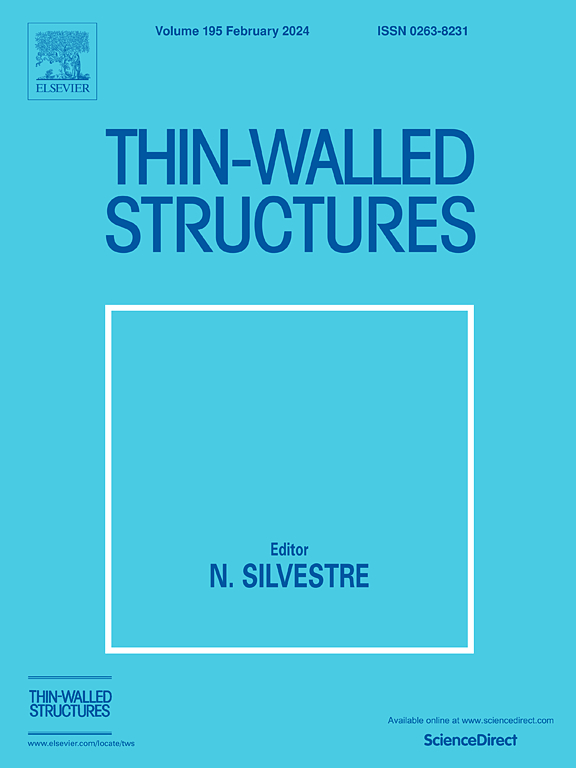具有形状记忆特性的二维碳纤维织物增强环氧树脂复合材料的多重自愈合和冲击特性实验研究
IF 5.7
1区 工程技术
Q1 ENGINEERING, CIVIL
引用次数: 0
摘要
纤维增强热固性聚合物作为一种性能优异的材料被广泛应用于航空航天领域。然而,对于它们最容易受到的低速冲击损伤,现有的修复方法很难在修复后保持部件的气动性能(恢复到损伤前的形状)。在本研究中,研究了具有形状记忆和自修复特性的环氧树脂-PCL(ε-己内酯)二维碳纤维织物增强聚合物的多次冲击变形恢复、内部损伤愈合以及修复后的冲击性能。该材料采用热压罐-预浸工艺制造,在 6 个大气压下于 160 °C 固化 3.5 小时。结果表明,在复合材料基体中加入热塑性 PCL 可增强材料的自愈合能力和抗冲击性。受到较低能量冲击的复合材料在愈合后仍能保持其结构完整性和机械性能。材料可以从单次撞击中有效恢复,但反复撞击会导致更大范围的损伤,从而增加愈合难度并降低愈合效率。复合材料的形状记忆效应可以恢复撞击造成的塑性变形,这凸显了形状记忆智能复合材料在航空航天应用中的潜力。本文章由计算机程序翻译,如有差异,请以英文原文为准。
Experimental study on multiple self-healing and impact properties of 2D carbon fiber fabric-reinforced epoxy composites with shape memory properties
Fiber-reinforced thermoset polymers are widely used in aerospace as a material with excellent performance. However, for the low-velocity impact damage to which they are most susceptible, existing repair methods are difficult to maintain the aerodynamic performance of the components (back to its pre-damage shape) after repair. In this study, the multiple impact deformation recovery, internal damage healing, and post-repair impact properties of epoxy-PCL (ε-caprolactone) 2D carbon fiber fabric-reinforced polymers with shape memory and self-healing properties were investigated. The material is manufactured using a hot press tank-prepreg process, curing at 160 °C for 3.5 h at 6 atmospheres. The results show that the incorporation of thermoplastic PCL into the composite matrix can enhance the self-healing ability and impact resistance of the material. Composites after lower energy impacts retain their structural integrity and mechanical properties after healing. Materials can recover effectively from a single impact, but repeated impacts can lead to more extensive damage, which makes healing more difficult and causes a decrease in Healing efficiency. The shape memory effect of composites can restore plastic deformation caused by impact, which highlights the potential of shape memory smart composites for aerospace applications.
求助全文
通过发布文献求助,成功后即可免费获取论文全文。
去求助
来源期刊

Thin-Walled Structures
工程技术-工程:土木
CiteScore
9.60
自引率
20.30%
发文量
801
审稿时长
66 days
期刊介绍:
Thin-walled structures comprises an important and growing proportion of engineering construction with areas of application becoming increasingly diverse, ranging from aircraft, bridges, ships and oil rigs to storage vessels, industrial buildings and warehouses.
Many factors, including cost and weight economy, new materials and processes and the growth of powerful methods of analysis have contributed to this growth, and led to the need for a journal which concentrates specifically on structures in which problems arise due to the thinness of the walls. This field includes cold– formed sections, plate and shell structures, reinforced plastics structures and aluminium structures, and is of importance in many branches of engineering.
The primary criterion for consideration of papers in Thin–Walled Structures is that they must be concerned with thin–walled structures or the basic problems inherent in thin–walled structures. Provided this criterion is satisfied no restriction is placed on the type of construction, material or field of application. Papers on theory, experiment, design, etc., are published and it is expected that many papers will contain aspects of all three.
 求助内容:
求助内容: 应助结果提醒方式:
应助结果提醒方式:


